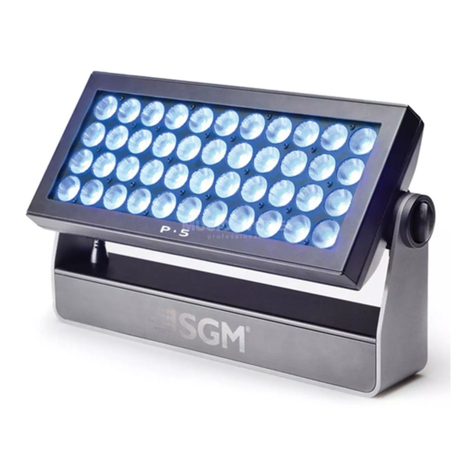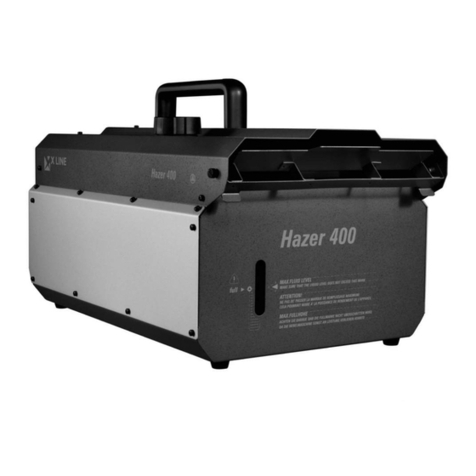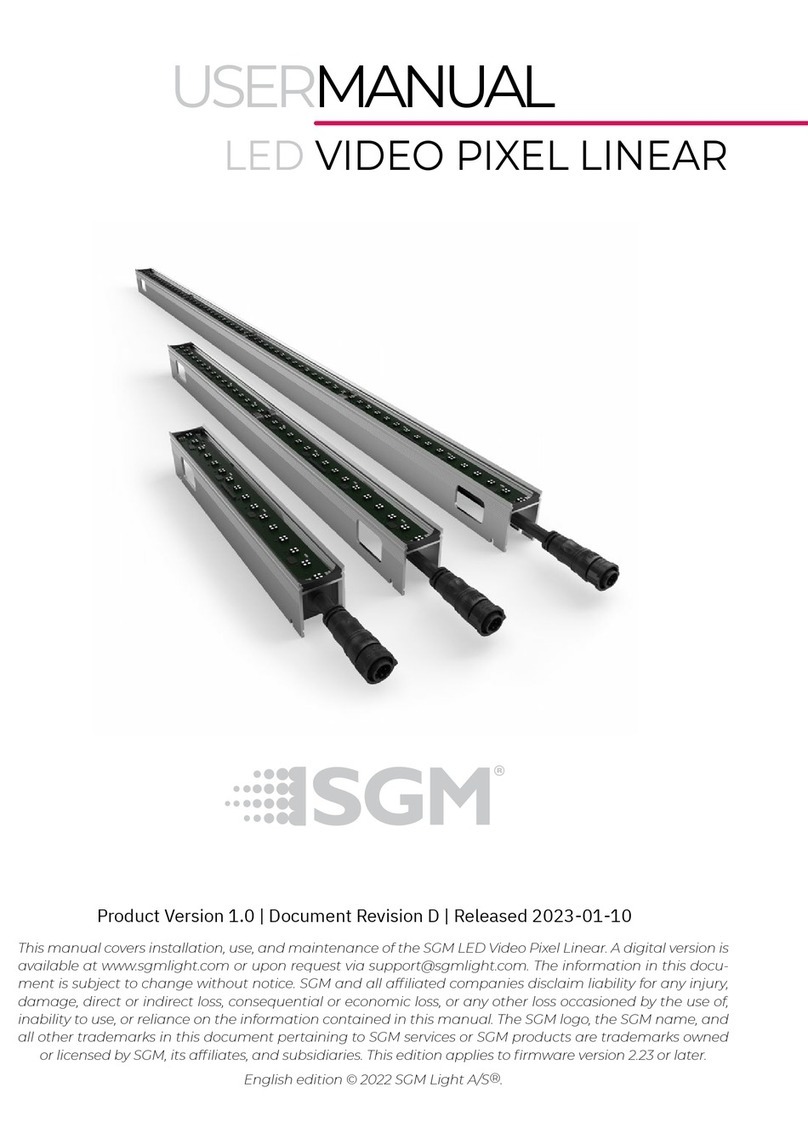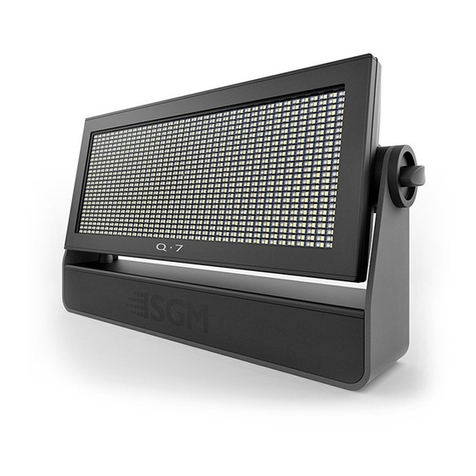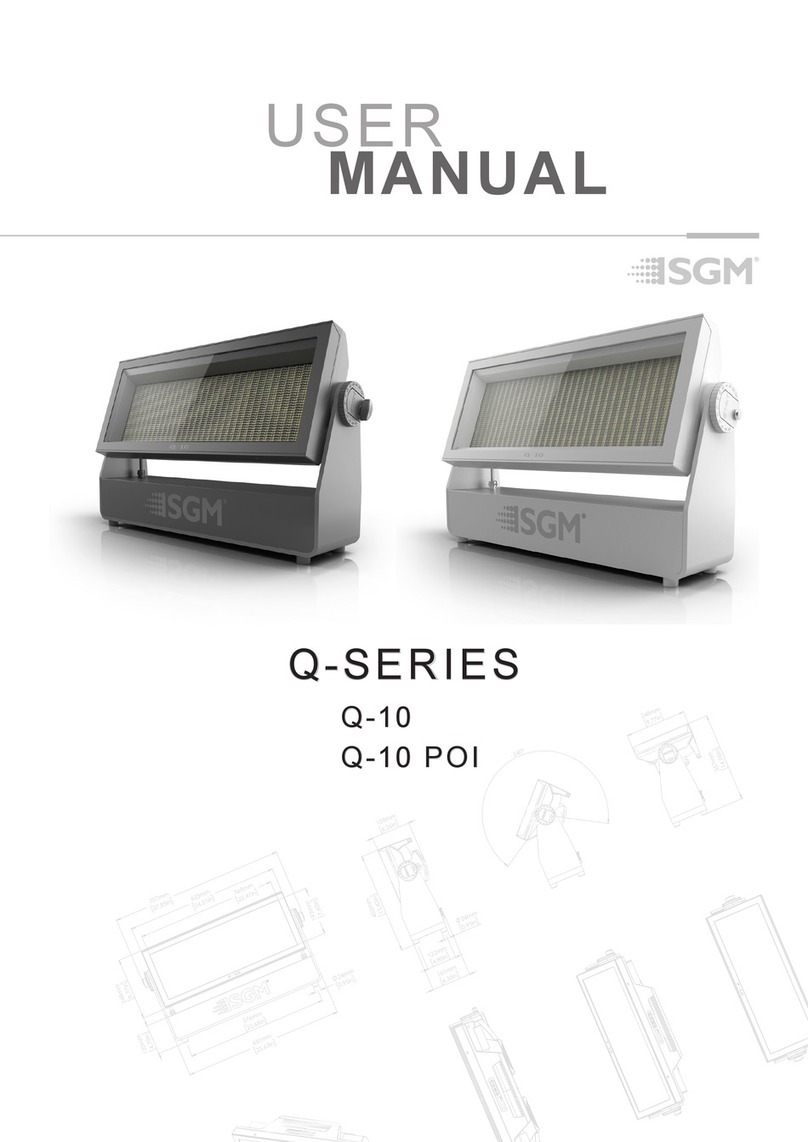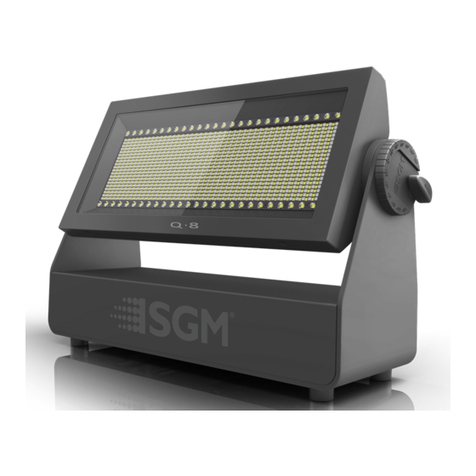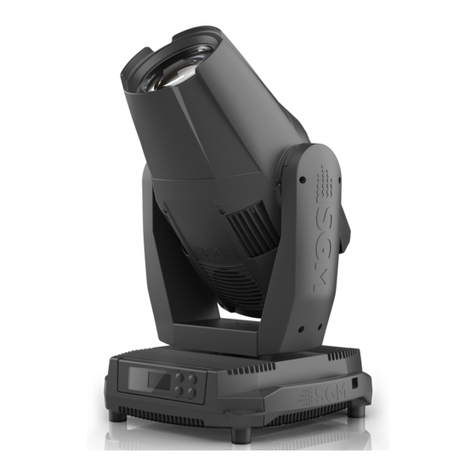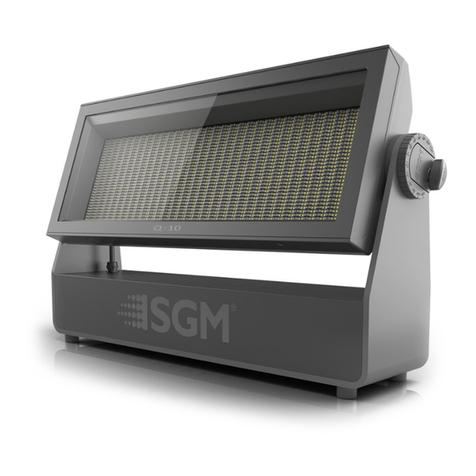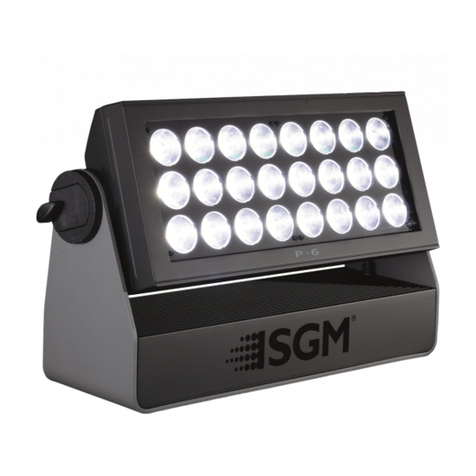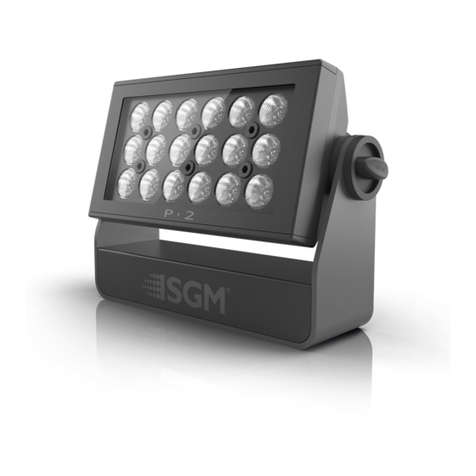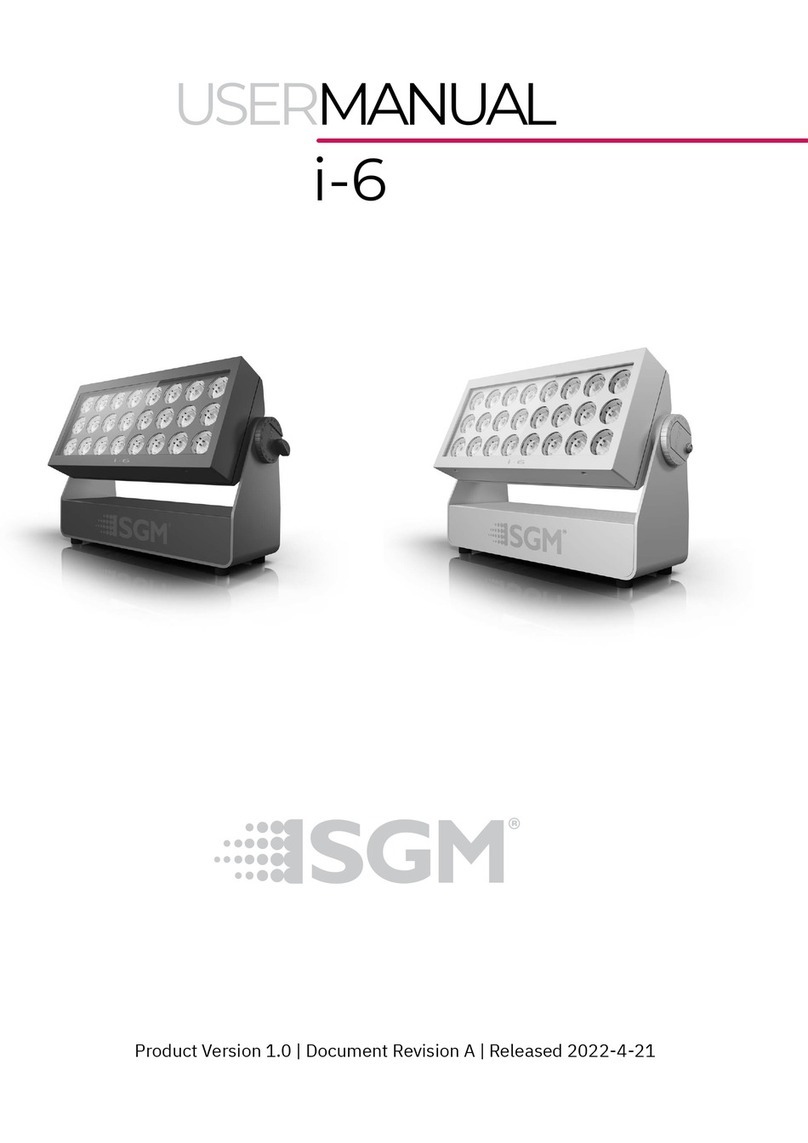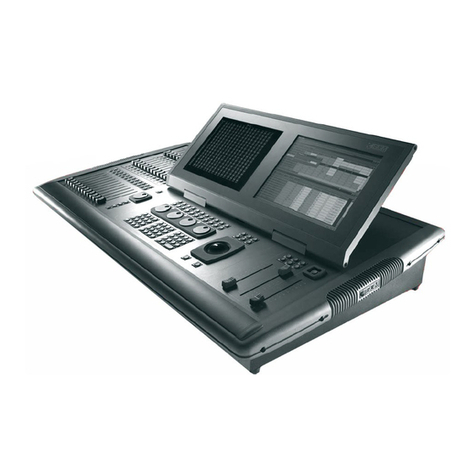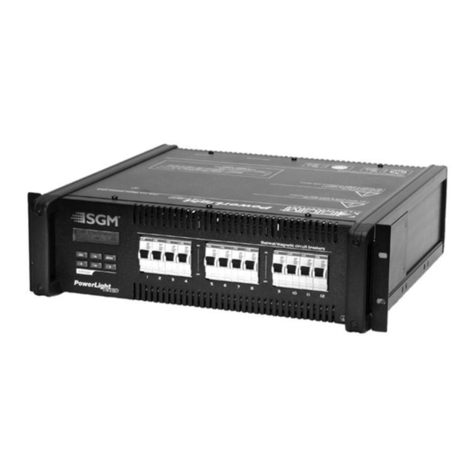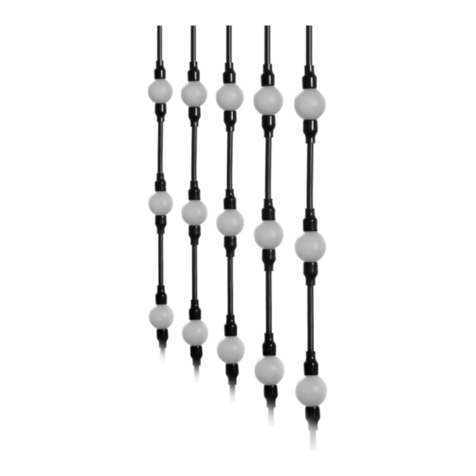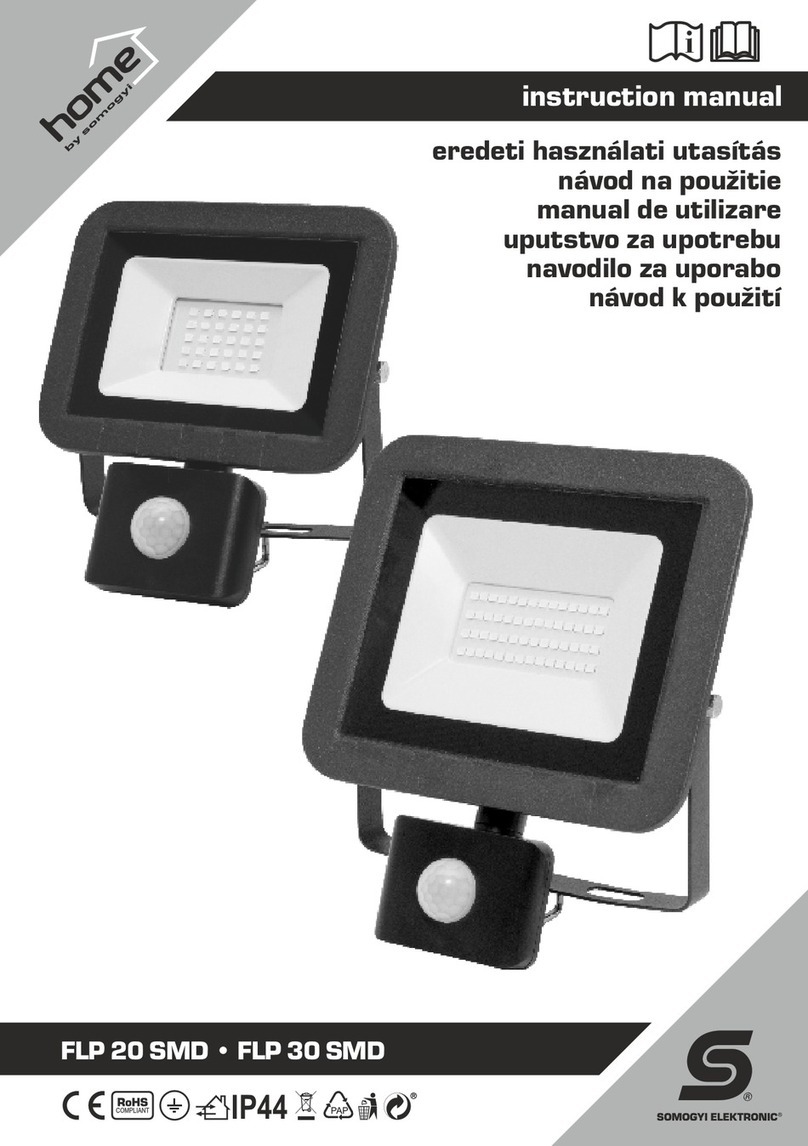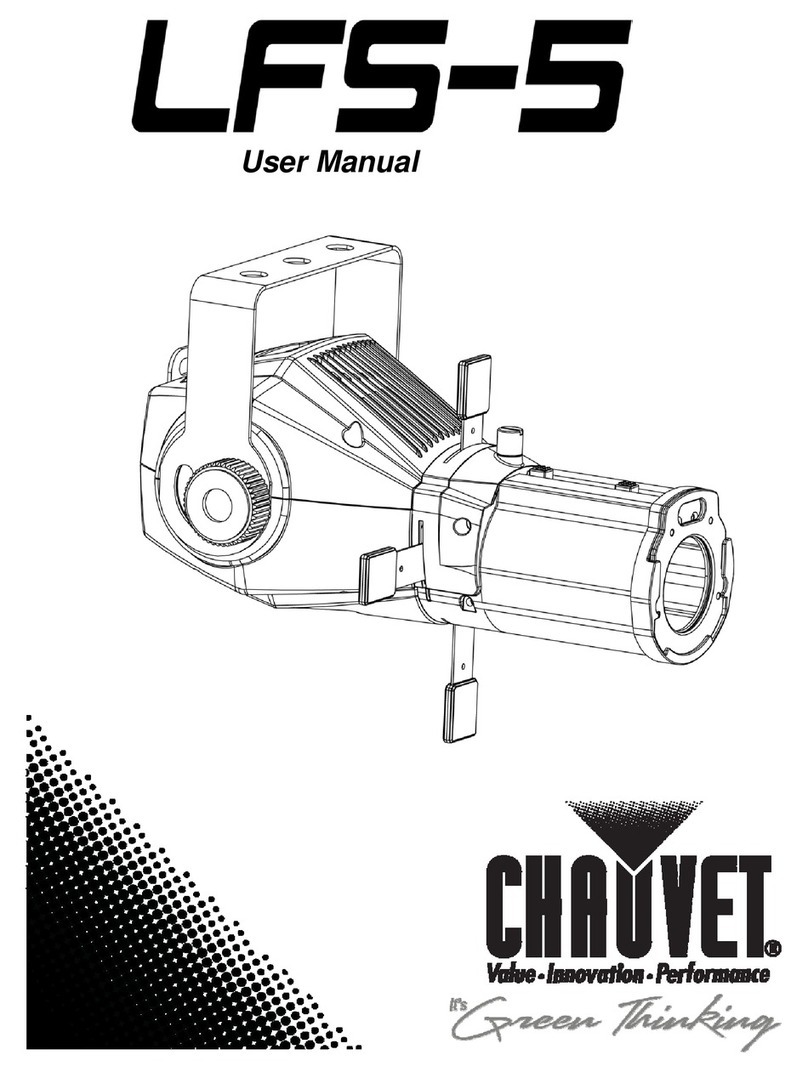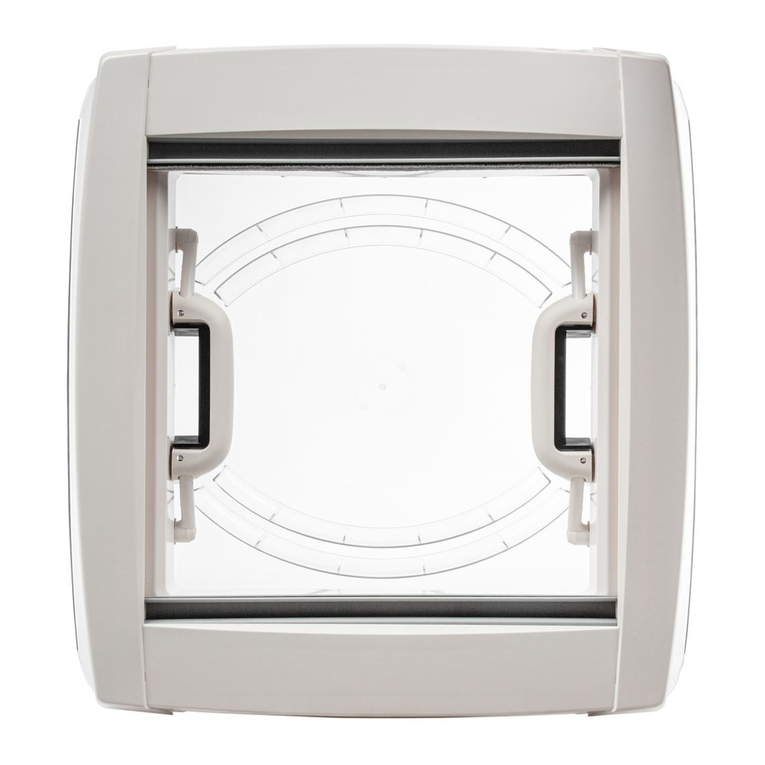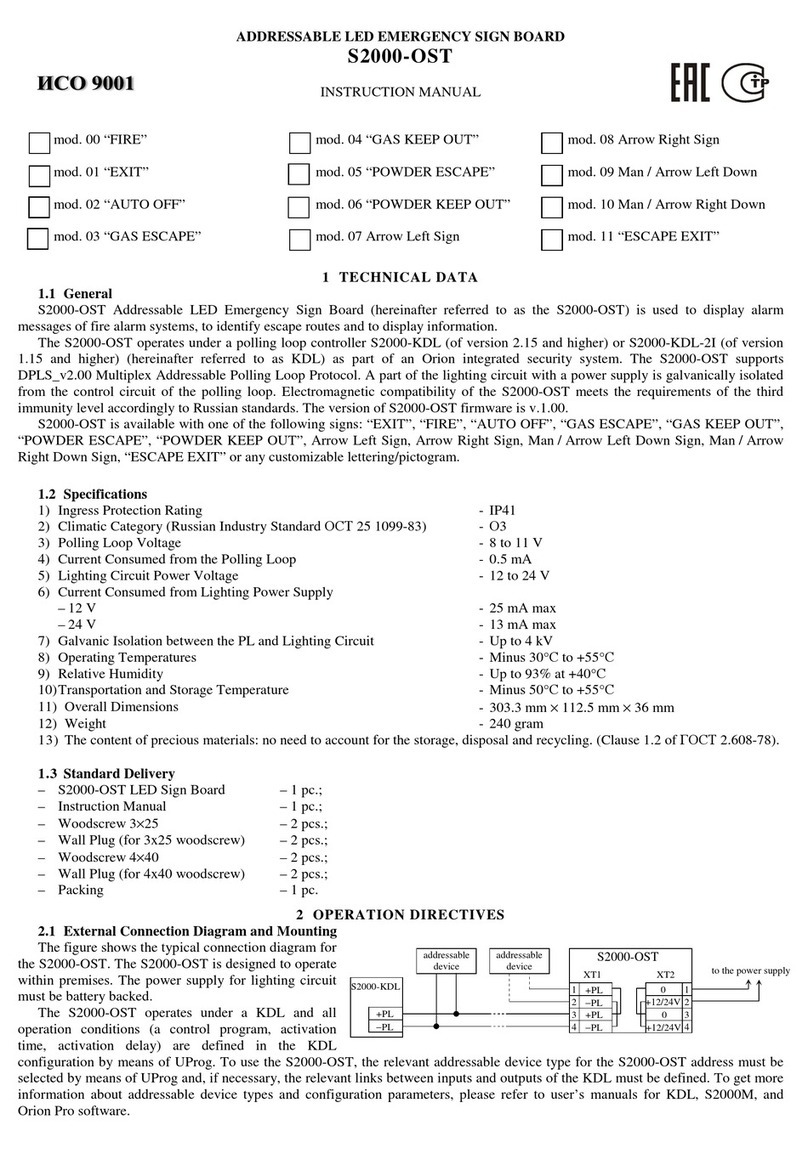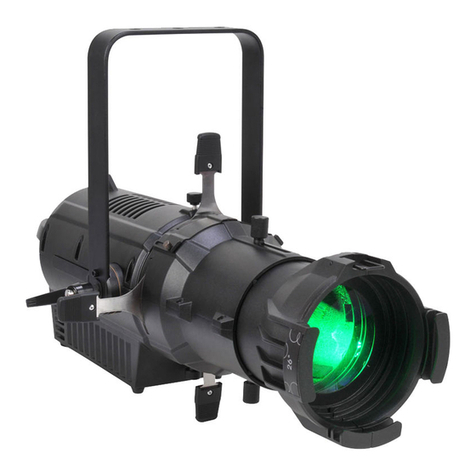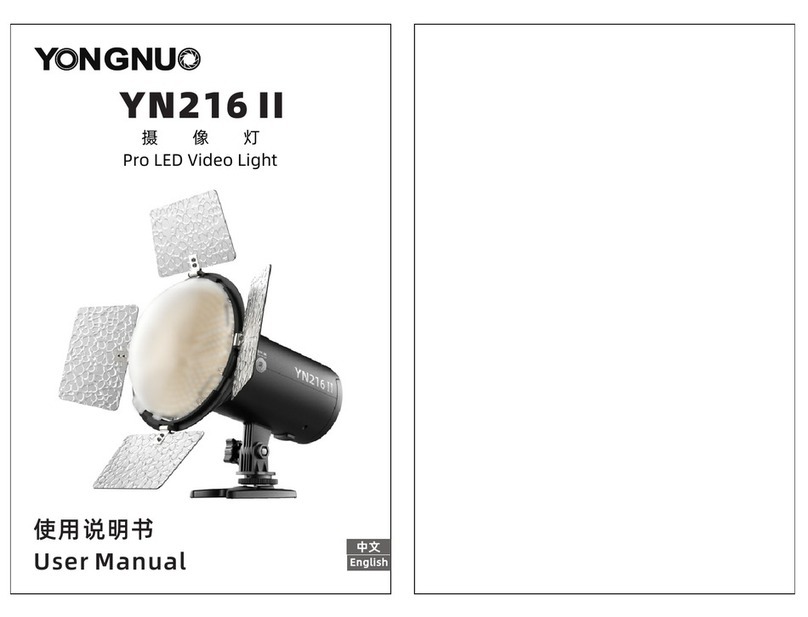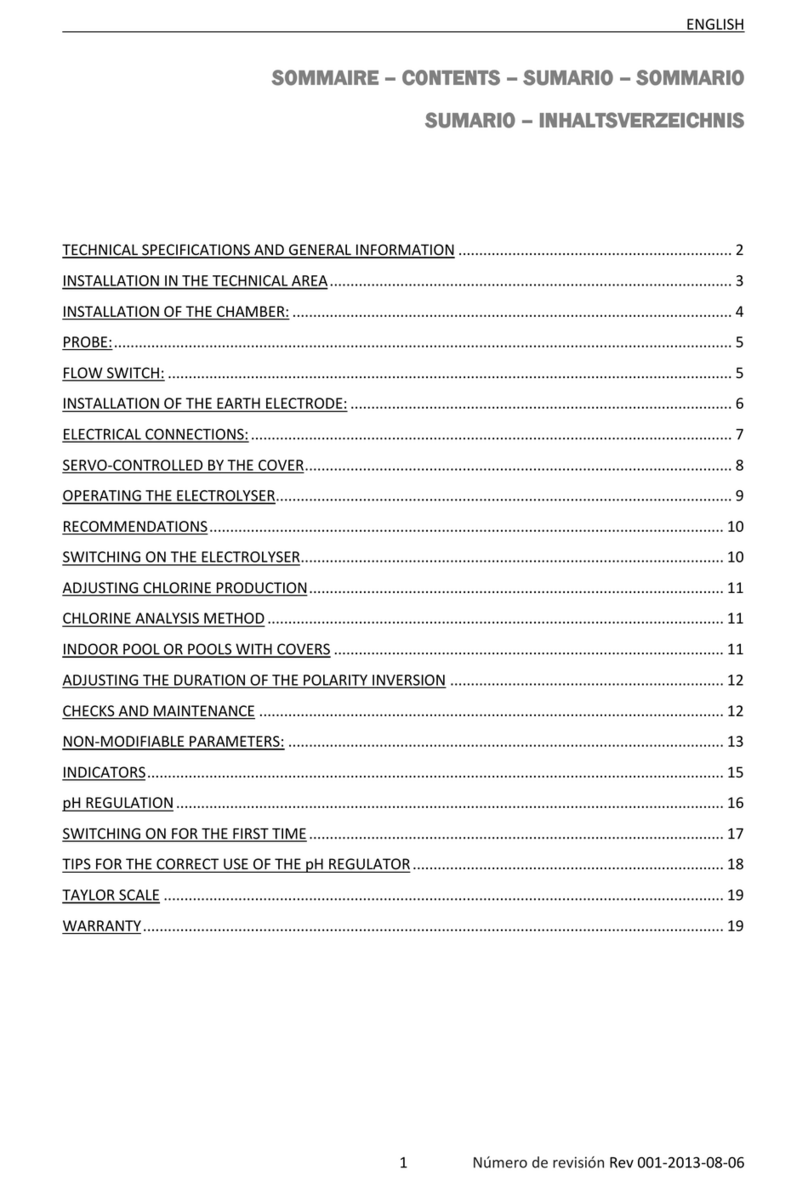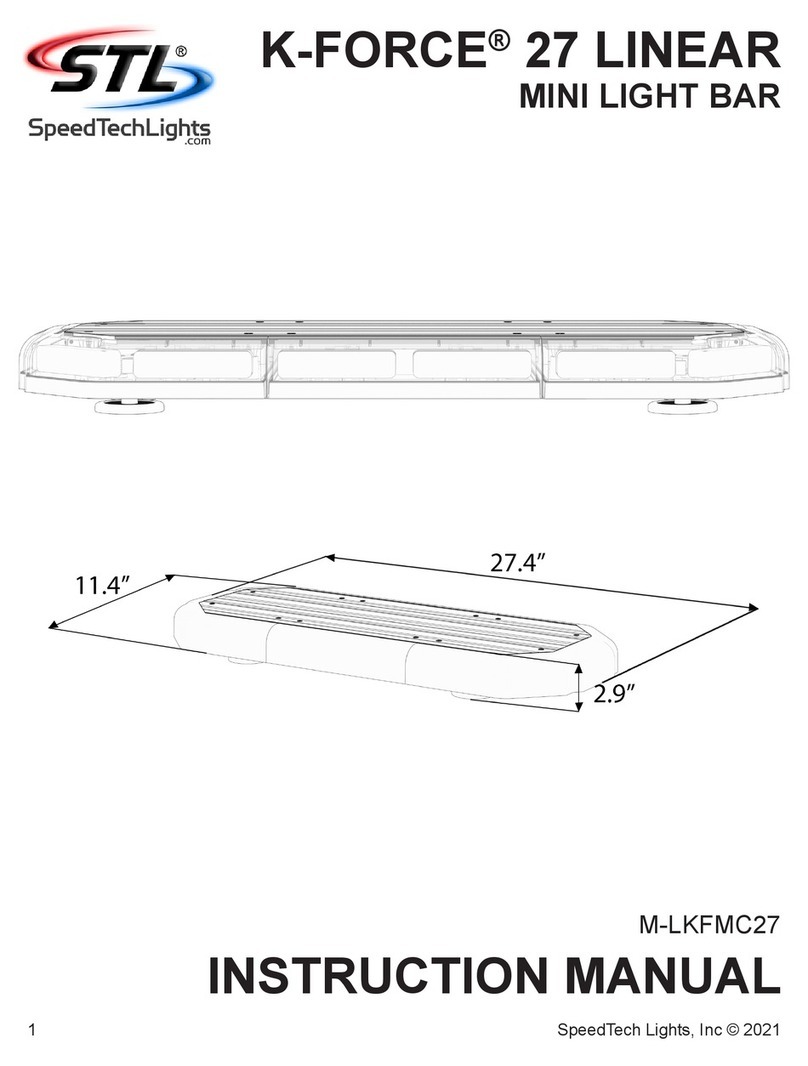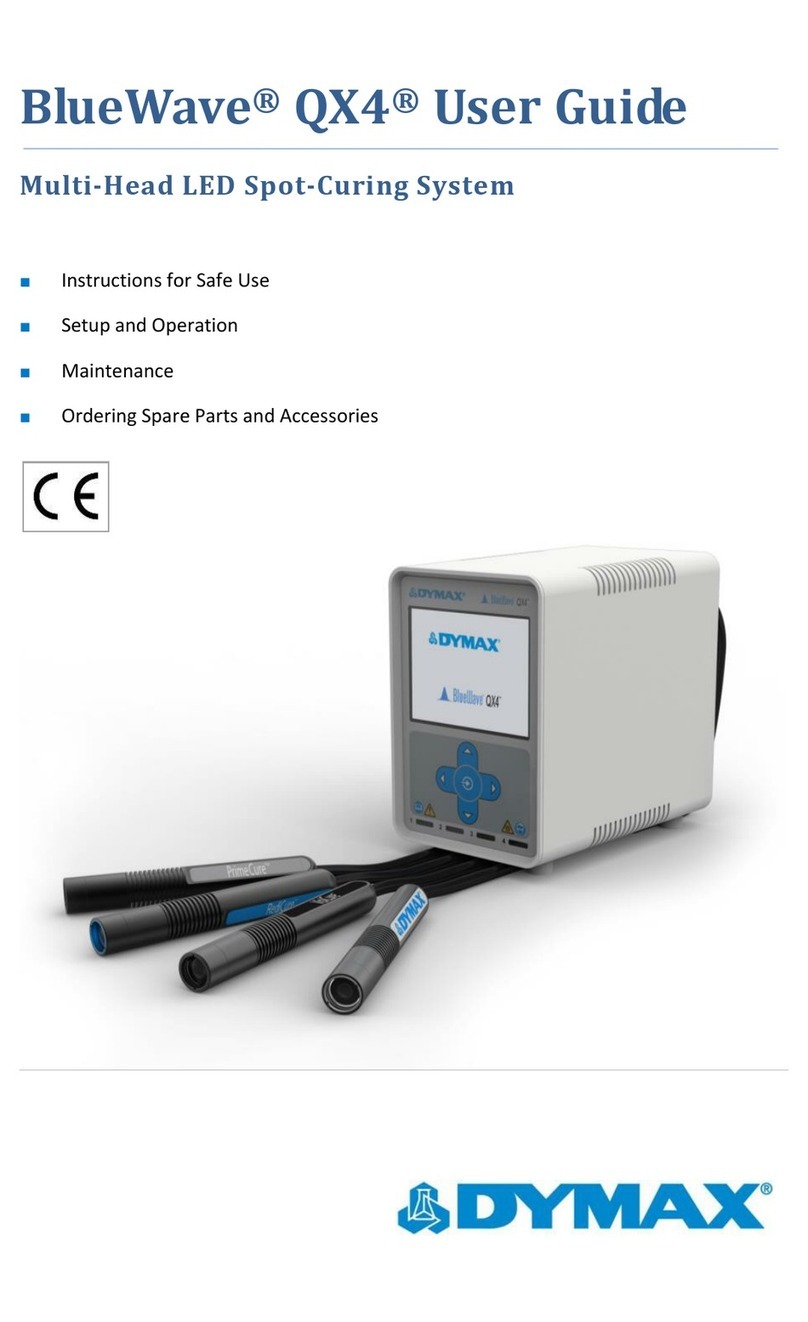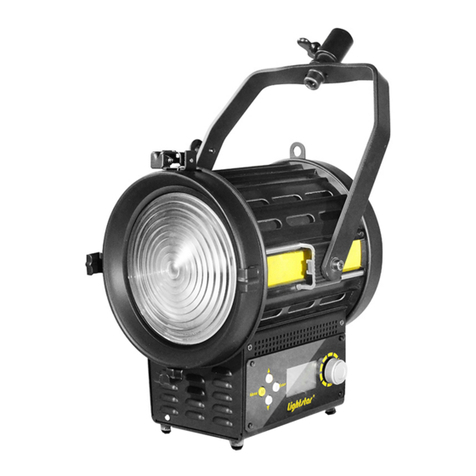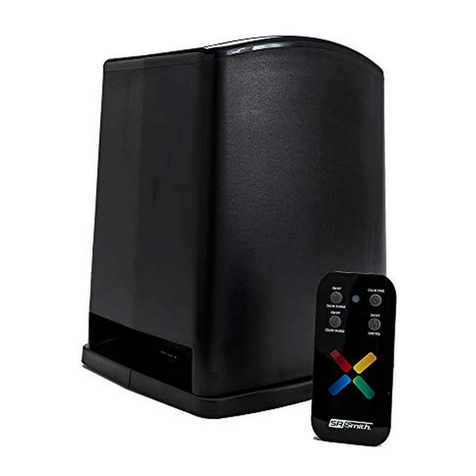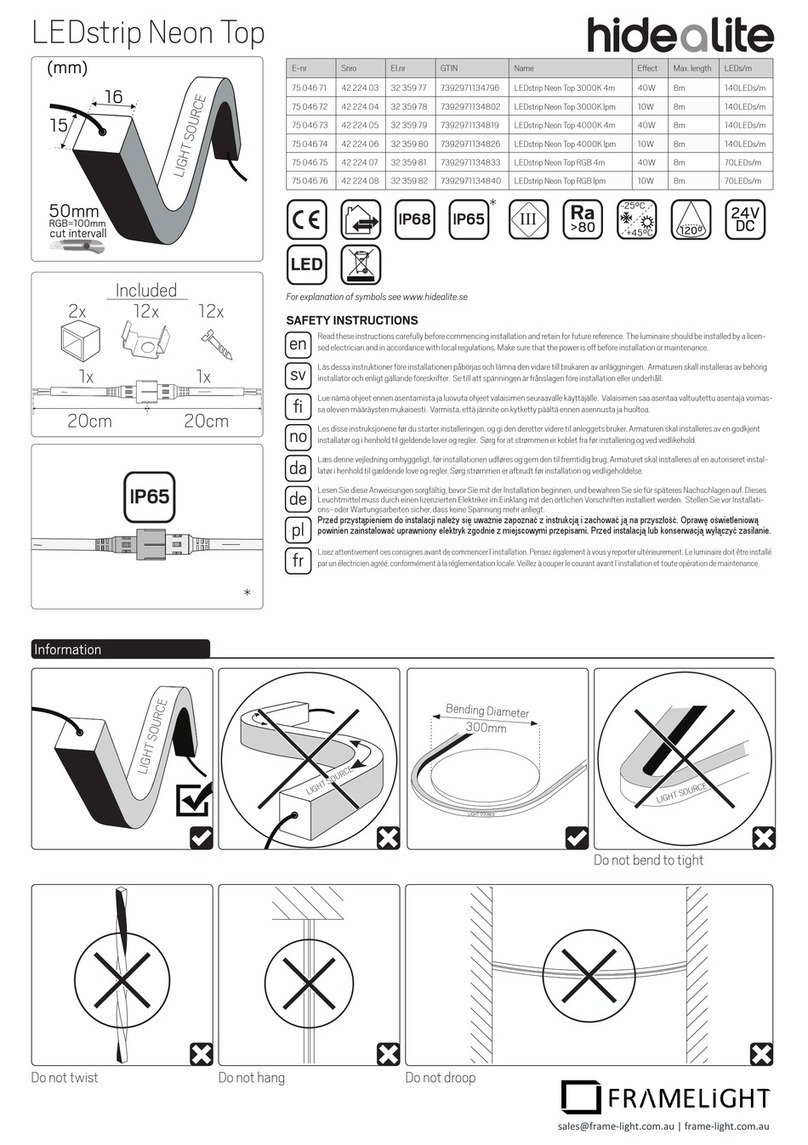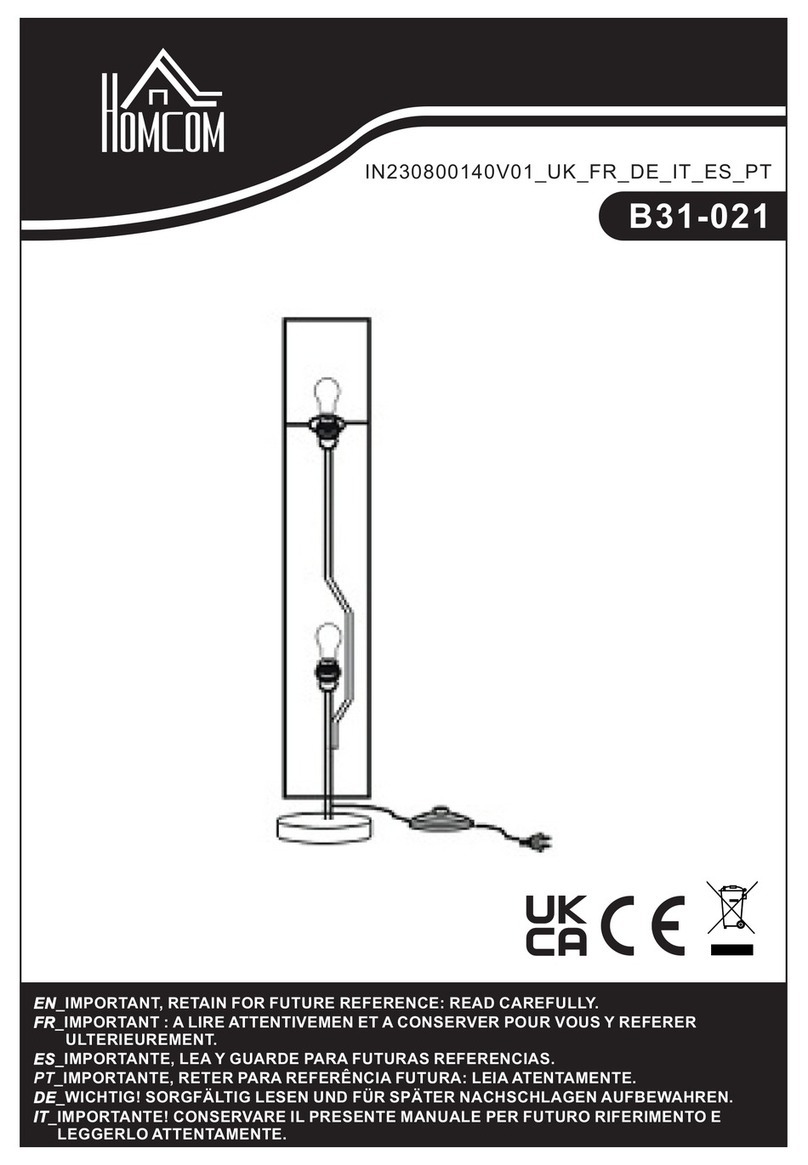SGM Flasher DMX 1.5 User manual

professional strobe projector
rel. 1.00
user manual
Flasher
D
DMX 1.5

EN
appendice
page 1
IDFE
General warnings
Carefully read the warnings contained in this manual, since they supply important instructions concer-
ning safety of installation, use and maintenance.
It is very important that this manual be kept with the equipment for future consultation.
In case of sale or transfer of the equipment to another user, ensure that this manual always
accompanies the equipment to allow the new owner to obtain information about the operation
and the relevant warnings.
• Not for residential use.
• After unpacking check the integrity of the equipment. In case of doubt, do not use the equipment,
and contact an authorized SGM Technical Service Centre.
• The packaging materials (plastic bags, expanded polystyrene, nails, etc.) must be kept out of reach
of children since they are potential sources of danger.
• This equipment may only be operated by adults. Do not allow children to tamper with the machine
or play with the product.
• The electrical and mechanical work necessary for the installation of the equipment must be carried
out by a qualified electrician or by a competent person.
• Before connecting the unit, check that the data on the registration plate is the same as that of the
electrical grid.
• Avoid using the equipment:
- in places subject to excessive humidity
- in places subject to vibrations or knocks
- in places with temperatures higher than 45°C or lower than 2°C
- Protect the equipment from excessively humid conditions
(the optimum values are between 35 and 80%).
• Do not disassemble or modify the equipment.
• Prevent inflammable liquids, water or metallic objects from penetrating the equipment.
• In case of spilling liquid on the equipment, immediately disconnect the power supply of the mixer.
• The minimum distance between the projector and the surface to be illuminated must not be less
than 1.5 m.
• In case of serious functioning problems, switch off the equipment and contact the nearest SGM
retailer or the manufacturer directly for inspection.
• Avoid opening the equipment: there are no parts repairable by the user.
• Never try to repair the equipment alone. Repairs carried out by inexpert persons may cause damage
or serious malfunctioning. Contact the nearest authorised Technical Service Centre.
Always insist on original spare parts.
Protect the environment: do not throw the packaging in your dustbin,
but return it to your retailer or take it to a collection point for special
waste disposal.

page 2
Index
1 General information
2 Index
3 Main features
3Lamp
3 Dimmer
3 Technical specifications
4 Positioning
4 Flasher DMX 1.5 maintenance
4 Access to internal components
4 Fitting the lamp and re-lamping
5 Cleaning the fixture / periodic checks
5 Switching the fixture on / fixture status
5 Start addresses
6 Connecting the Flashers
6 Control channels
6 ch 1 - dimmer
6 ch 2 -strobe
Made in Italy by SGM Electronic
Printed in July, 1998 • Rel. 1.00

EN
appendice
page 3
I D F E
Main features
SGM’s new Flasher DMX 1.5 strobe unit is another result of the firm’s lengthy experience in manufac-
turing this type of fixture. The quality and design philosophy are those which all SGM products have
had in common for years and the sophisticated electronics used combined with ground-breaking
performance earn it a rightful place at among the world’s top products.
In-depth function study, an on-going search for innovative materials, technical updating and constant
research aimed at ensuring even further safety have resulted in a truly unique product.
The mechanism and electronics were designed entirely by our in-house research labs, ensuring com-
plete command of all know-how and an optimum quality:price ratio.
Like all other SGM products, the Flasher passed the firm’s long trail period and strict tests brilliantly
before being put on the market, ensuring high quality and reliability up to the firm’s customary stan-
dards.
Particular care taken with the unit’s looks and optimisation of the outer structure to ensure functiona-
lity enable the fixture to be easily installed in any position and ensure extremely rapid maintenance.
The Flasher is built in compliance with current CE norms
Lamp
The Flasher is fitted with a Xenon XOP15 lamp with exceptional luminous output optimized by electro-
nic control.
Dimmer
The Flasher also has a dimmer function that enables flash power to be adjusted from zero to 100%.
Technical Specifications
Power required 90-260V, 50Hz, 60Hz - universal, automatic voltage changer
Lamp 1,500W - XOP15, special base
Power absorbed 400W
Reflector Polished aluminium with high transmission factor
Electronics Completely designed by SGM R&D lab engineers.
Main board (CS 0218), input board (CS 0217) and IGBT controller board (CS 0228).
Settings Via rotary dip switches for addressing the fixture’s control channels.
Input ch1 - dimmer / ch2 -strobe
Safety norms Protected to IP20. Automatic power cut-off in the event of overheating or
faulty cooling system operation.
Cooling Forced ventilation via an axial fan.
Body Sheet metal with epoxy powder finish
Mounting bracket Steel metal with epoxy powder finish
Dimensions 49 x 21 x 17 cm. Weight: 5.6kg.
SGM Elettronica reserves the right to carry out improvements or modifications on its products
without prior notice. Always consult the handbook of the unit being used to avoid errors and
any difference between actual functions and handbook contents.

Flasher DMX 1.5 maintenance
Access to internal components
The Flasher has a system for access to the fixture’s internal components, which prevents accidental
opening. To open the fixture, it must be dismantled from its operating position and disconnected from
the mains supply: screw 1 can then be unscrewed. Once side panel 2 has been removed, the front
glass (3) must be removed extremely carefully. If the fixture must be completely dismantled, screw 4
and side panel 5 must also be removed. The lamp and reflector can then be removed for access to the
electronics.
Fitting the lamp and re-lamping
ATTENTION: Before re-lamping, make certain that it’s really necessary and discon-
nect the fixture’s main power supply. If the unit has been used recently, wait for
the lamp and mechanical parts to cool before opening (10 - 30 minutes).
Be very careful to avoid touching the reflector and the actual lamp with your bare
hands, as any residue subject to high temperature burns, causing components to
blacken, and definitively damages the lamp. Fit the new lamp carefully.
After re-lamping, it’s always advisable to clean the fixture completely.
ATTENTION: T
HIS TYPE OF LAMP MUST ONLY BE REPLACED BY QUALIFIED PERSONNEL SUF
-
FICIENTLY INFORMED ON RISKS AND METHODS OF OPERATION
.
Cleaning the fixture / periodic checks
Cleaning the glass and reflector (inside and out) is decisive for the utmost lumi-
nous output and must be carried out periodically. Cleaning frequency depends
2
3
5
1
4
page 4
Positioning
To position the fixture, set the channels as follows:
Channel 1 dimmer 100% open
Channel 2 strobe positioned at 128 (ref. scale 0÷255)
Position the fixture by turning it on the support bracket and locking in the required position using the
bolts supplied.
Flasher does not require focussing.
Trouble-free horizontal, vertical or tilted positioning is possible, provided sufficient space is left round
the unit for air circulation.

EN
appendice
page 5
I D F E
above all on the surroundings in which the unit is used: damp, smoky or dusty surroundings in particu-
lar favour a greater build-up of dirt on the unit’s glass.
Clean using a soft cloth and normal glass cleaning products or methylated spirits, always being certain
to dry the parts. Clean the outside of the glass at least every 15/20 days and the inner group at least
every 40/60 days.
To ensure utmost fixture efficiency, it’s advisable to carry out a general periodic check-up every 700
running hours. Electrical and mechanical components must be checked by qualified technical person-
nel.
Start addresses
When connecting, each fixture must be appropriately configured.
The start address is set using the rotary dip switch located on the rear of the fixture. The address can
be changed even when the fixture is on.
The lowest start address is 001. When 000 is used as the address, as in the following example, the
Flasher’s built-in computer uses 001 anyway.
0
9
8
7
6
5
4
3
2
1
0
9
8
7
6
5
4
3
2
1
0
9
8
7
6
5
4
3
2
1
0
9
8
7
6
5
4
3
2
1
0
9
8
7
6
5
4
3
2
1
0
9
8
7
6
5
4
3
2
1
0
9
8
7
6
5
4
3
2
1
0
9
8
7
6
5
4
3
2
1
0
9
8
7
6
5
4
3
2
1
Flasher #1 (ch 1 ÷2)
Flasher #2 (ch 3 ÷4)
Flasher #3 (ch 5 ÷6)
x 100 x 10 x 1
Switching the fixture on / fixture status
The Flasher doesn’t have a manual switch for turning it on. In fact its special electronics check the
DMX signal line continually and only turn on the fixture when the control signal is sent.
In particular, when channel 2 (see further ahead) is set at 0 (zero), the fixture automatically goes into
stand-by.
The power supply connector is used as a local cut-out. The red pilot light below the connector indica-
tes that there is voltage on the in-coming power line.
The green “DMX OK” LED indicates that the connection of the DMX network is operating and the
signal matches protocol specs.
The red “SYSTEM FAILURE” LED lights up when the lamp doesn’t light up, in spite of the DMX com-
mand. Striking lasts for a very short period (approx. 1 sec.).
In this case, call the nearest assistance centre, disconnect the fixture from the mains supply
and carry out a check.

page 6
Control channels
dimmer
Channel 1 allows linear control of luminous intensity from zero to 100%.
When channel 2 (strobe) is set at 0 (zero), channel 1 enables SINGLE SHOOT use.
In this case, a single flash is given at the power required by the operator: it’s sufficient to use the
channel 1 slider on the desk or the controller starting from 0 and stopping at the value of the required
scale (parameter 0÷10, 0÷255 or 0÷100, according to the controller used).
When the value of channel 1 or channel 2 is 0 (zero), the fixture automatically goes into standby: the
Flasher doesn’t in fact have a power switch, which is replaced by the control electronics.
strobe
Channel 2 allows the flash rate of the Flasher to be regulated continuously.
The range goes from zero to 50 flashes per second, i.e. from off to continuous light.
When channel 1 or channel 2 are set at 0 (zero) the fixture automatically goes into standby: the Flasher
doesn’t in fact have a power switch, which is replaced by the control electronics.
Setting the strobe at 0 (zero), enables SINGLE SHOOT use (see channel 1 - dimmer).
ch 2
ch 1
Connecting the Flashers
The fixture has DMX 512 input/output.
For connection, always use quality balanced microphone cables
such as RF 60/12 2x0.25mm2or similar to avoid faulty fixture
operation.
To reduce interference, it may be necessary to fit the last fixture
in the DMX chain with a system terminator, made using a
120Ohm 1/4W resistor between pins 2 and 3 on the DMX con-
nector.
Attention: the cable screen (sheath) must NEVER be con-
nected to the system’s ground as this would cause faulty
fixture and controller operation.
Flasher Flasher Flasher
DMX512 line
Flasher #1 Flasher #2 Flasher #n
DMX socket pin out
pin 1
comm
12
3
outputinput
12
3
4
5
4
5
pin 2
- DMX
pin 3
+ DMX

Via Pio La Torre, 1 • 61010 TAVULLIA (PS) • ITALY •
Tel. +39 0721476477 • Fax +39 0721476170
cod. M001165
Table of contents
Other SGM Lighting Equipment manuals

